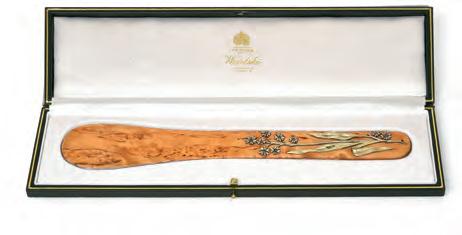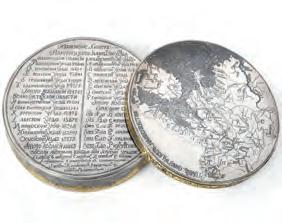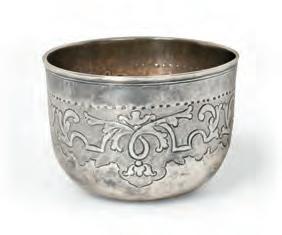
6 minute read
Previews a single owner collection of Russian decorative arts
SALEROOM SPOTLIGHT
Works of art by Fabergé and other leading Russian silversmiths of the 18th and 19th centuries go under the hammer in North Yorkshire this month
A Russian silver-mounted stoneware bowl by Doulton, Lambeth dated 1879 with silver mounts by Fabergé, has an estimate of £3,000-£5,000 at this month’s sale

Russian silver and works of art amassed over three decades go under the hammer this month. They come from a large family collection of art and antiques, once housed in a property in St Judes on the Isle of Man, now up for sale as part of Tennants’ series of Spring sales. A selection of 18th and 19th century silver niello snuff boxes and bonbonnieres will take centre stage.

Notable niello
Niello is a type of monochrome enamelling, in which a black compound of sulphur with silver, lead or copper is applied to the surface of an engraved piece of metalwork, usually silver. Mastered during the Renaissance, it then became a popular technique in Russia from the 17th to 20th centuries.
All the niello pieces in the collection were inventoried by Wartski of London, leading dealers in
Far right A Russian parcel-gilt silver twohandled cup and cover by Alexei Ratikov, Moscow, 1793, assay master Andrei Titov. It has an estimate of £2,000-£3,000 at this month’s sale
Right A Russian parcelgilt silver and niello snuff box by Vasilii Zalesov, St Petersburg, 1839. It has an estimate of £1,500£2,500 at this month’s sale
Below right A Russian silver-gilt mounted birch paper knife by Fabergé, Moscow, c. 1890, later retailed by Wartski, 14 Grafton Street, London. It has an estimate of £2,000-£3,000 at this month’s sale Above A Russian silver-gilt and niello charka (drinking cup), Moscow, 1768 It has an estimate of £250-£350 at this month’s sale
Fabergé and fine Russian works of art. Of particular note is a bonbonnière engraved in Cyrillic and made by Vassily Romanov of Veliki Ustyug in 1783. Other highlights include an unusually-shaped snuff box made by Vasilii Zalesov of St Petersburg in 1839. Based on traditional Russian drinking cups, it has a looped handle and hinged cover and is decorated with a coat-of-arms.
Fantastic Fabergé
Unexpectedly, Fabergé is well represented in the collection, with the Russian jeweller, silver and goldsmith supplying the mounts for a stoneware bowl made by Doulton of Lambeth. Purchased from Wartski in 1999, the gourd-shaped bowl is inscribed with the potter’s initials ‘AG’ and dated 1879.
Fabergé designed silver mounts for a wide range of fashionable pottery and glass in the second half of the 19th century, including Gallé.
Also in the sale is a silver-gilt mounted paper-knife by Fabergé, c. 1890, with an impressive provenance. In the 1970s, the birch knife was a gift from Wartski’s managing director, Kenneth Snowman, to an important American collector whose treasures included a Fabergé gnome, which went on to sell for almost $1.4m.
When the collection was dispersed at Christie’s New York, the paper-knife went to the New York dealer and Fabergé specialist, A La Vielle Russie, for $16,800. It later sold again at Christie’s London where it was purchased by Wartski for the present vendor’s family.


Imperial glass
In the early 20th century, traditional Russian glass-cutting skills were adapted to contemporary designs, as seen in this vase made by the Imperial Glassworks in 1915. Known as the St Petersburg Glassworks until 1792, it supplied the Russian Imperial Court and was particularly famed for its fine cut glass. Each piece was marked with a Royal cypher, with this vase engraved to the base with the monogram for Nicholas II and the date.




Bronze highlights
Vasily Yakovlevich Grachev (18311905) and Eugeny Alexandrovich Lanceray (1846-1886) were two leading late 19th-century Russian sculptors, and fine bronzes by both can be found in the collection. In direct competition, the two sculptors inspired each other to create
ever-more detailed bronzes, full of movement and life. Highlights include Lanceray’s Two Mothers, depicting a mother and child with a mare and her foal and Grachev’s bronze figure group of a Cossack embracing a woman on horseback.

AUCTION fact file
WHAT: The Selected Contents of a Private House in St Judes, Isle of Man When: Part of the Spring Fine Sale and the Jewellery, Watches and Silver Sale on March 18-19 Where: Tennants Auctioneers, Leyburn, North Yorkshire, DL8 5SG Viewing: March 13 (11am-4pm), March 14-18 (10am-4pm) and the mornings of the sales from 8am. Also online at www.tennants.co.uk
Above left A Russian imperial Glassworks green overlay blue vase, 1915, engraved with the monogram of Nicholas II. It has an estimate of £2,000-£3,000 at this month’s sale
Right A Russian parcelgilt silver and niello bonbonnière by Vassily Romanov, Veliki Ustyug, 1783, Assay Master Alexei Torlov, has an estimate of £4,000-£6,000
Left After Vasily Yakovlevich Grachev (1831-1905), a bronze figure group of a Cossack and woman on horseback. It has an estimate of £2,000-£3,000
Below left After Eugeny Alexandrovich Lanceray (1846-1886), Two Mothers has the same estimate at this month’s sale
Below right A Russian silver tumbler-cup by Grigory Serabrayanikov, Moscow, c. 1760, has an estimate of £200-£300
IN MY OPINION...
We asked Tennants’ silver specialist Jeffrey Lassaline for his sale highlights How important is the collection?
Niello is something Russian silversmiths excelled in from the 17th century and the collection has a rich offering of examples. Important makers represented in the collection include Fabergé and Ivan Zhilin – one of the pre-eminent silversmiths producing niello boxes in Veliky Ustyug. One such was even chosen by Alexander von Solodkoff for his 1981 book Russian Gold and Silver.
Have you got a favourite lot?
It would have be the 1783 bonbonnière with a niello map of the Vologodskaya oblast (region) in northwest Russia on the cover and its population statistics. These cartographic boxes were a specialty of the box makers of Veliky Ustyug and there is also a view of the town on the side of the box. It is in lovely condition and intricately decorated.
Where do you expect interest to come?
Russian collectors, either in Russia, the wider Commonwealth of Independent States or around the world, are always keen to purchase examples of their cultural heritage. There is also a long tradition of buyers from elsewhere in the world collecting Russian works of art, and the sale will appeal to collectors who love beautiful objects.
How is the current market?
The market for Fabergé continues to be strong. The last Fabergé silver piece we sold in 2021 was an early 20th-century silver vase possibly made to commemorate the anniversary of the birth of Empress Elizabeth in 1709. It attracted a great deal of interest before the sale and ended up selling for £3,200, almost five times its pre-sale estimate. The broader market for small, decorative objects of vertu and silver boxes is also strong.
Is there anything to attract the new collector?
I intentionally included some smaller and more affordable objects to give new buyers a real chance of starting to build a collection.
IN THE Loupe
This month’s dazzling birthstone aquamarine is in the spotlight, on its 50th anniversary we celebrate Audemars Piguet’s iconic Royal Oak watch and reveal why collectors have their sights on pearls
A gold ring with aquamarine and diamonds, image Shutterstock




